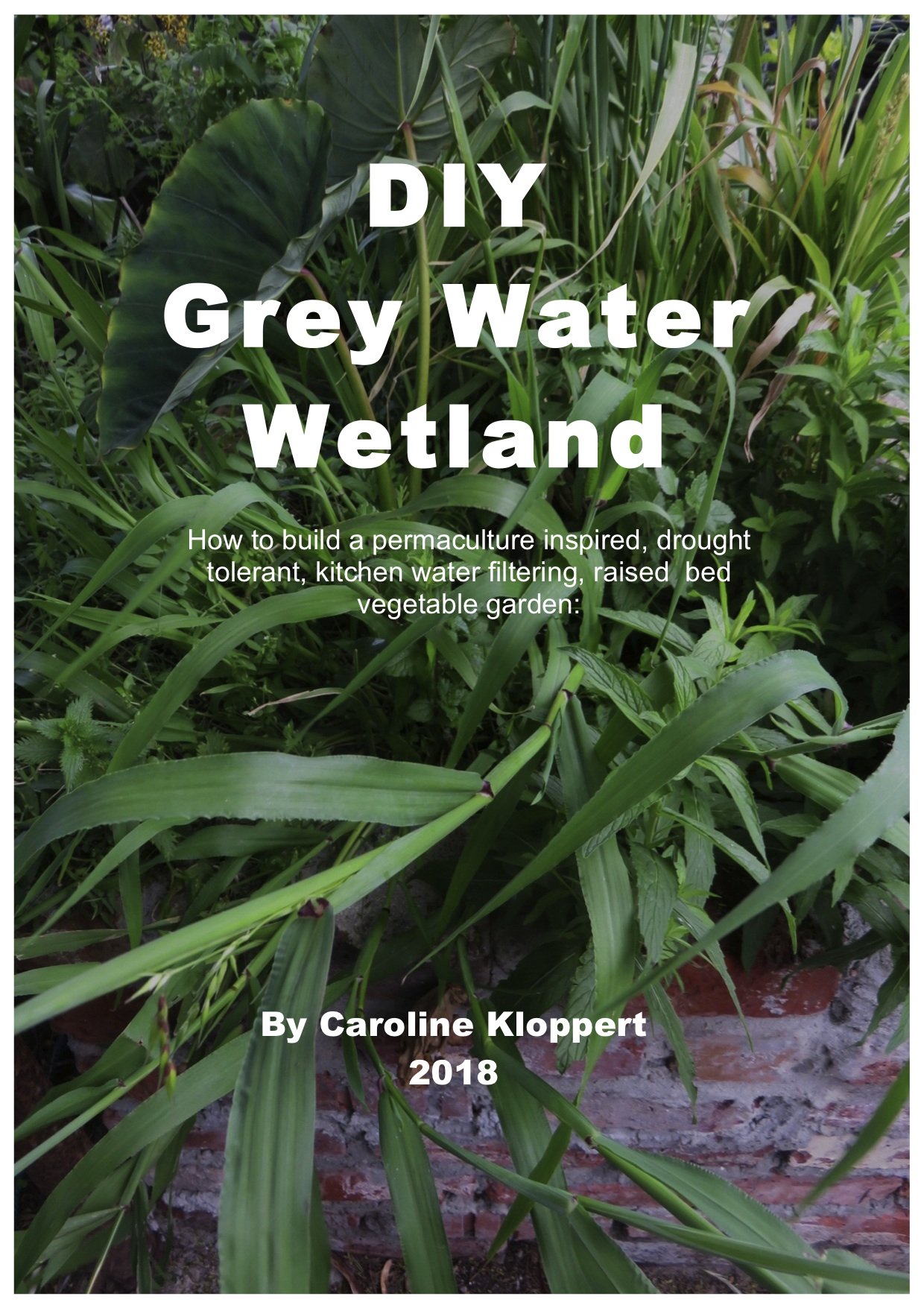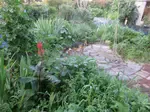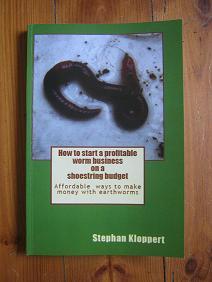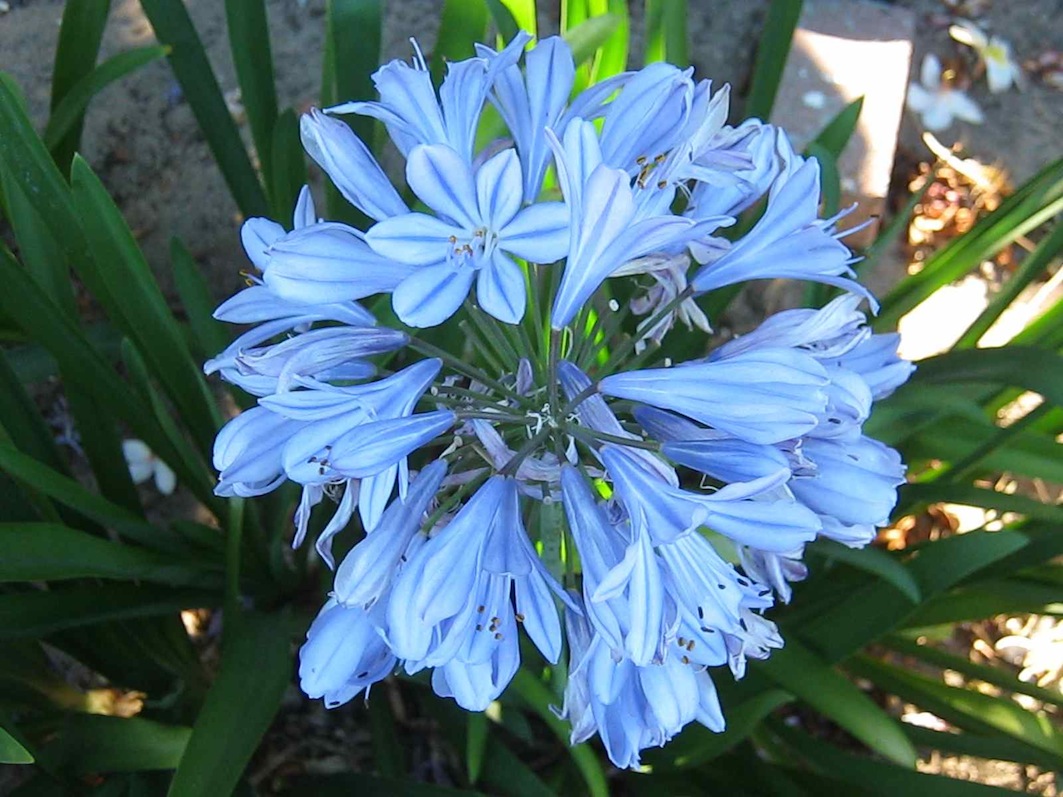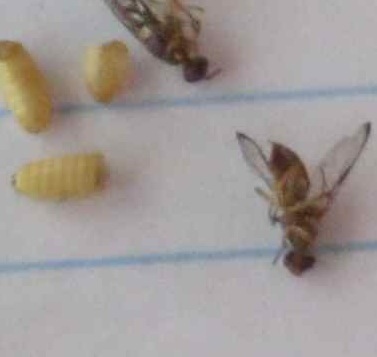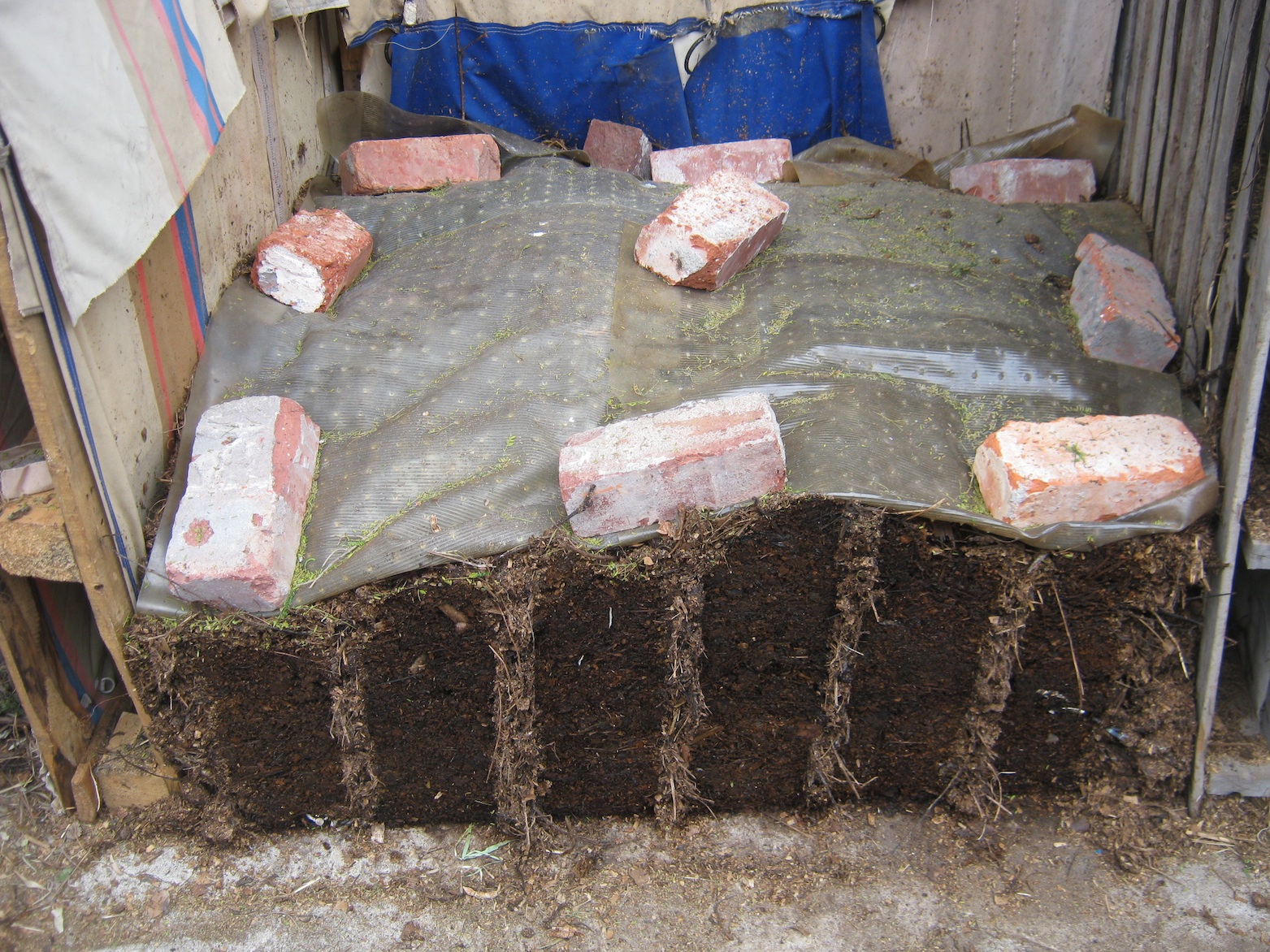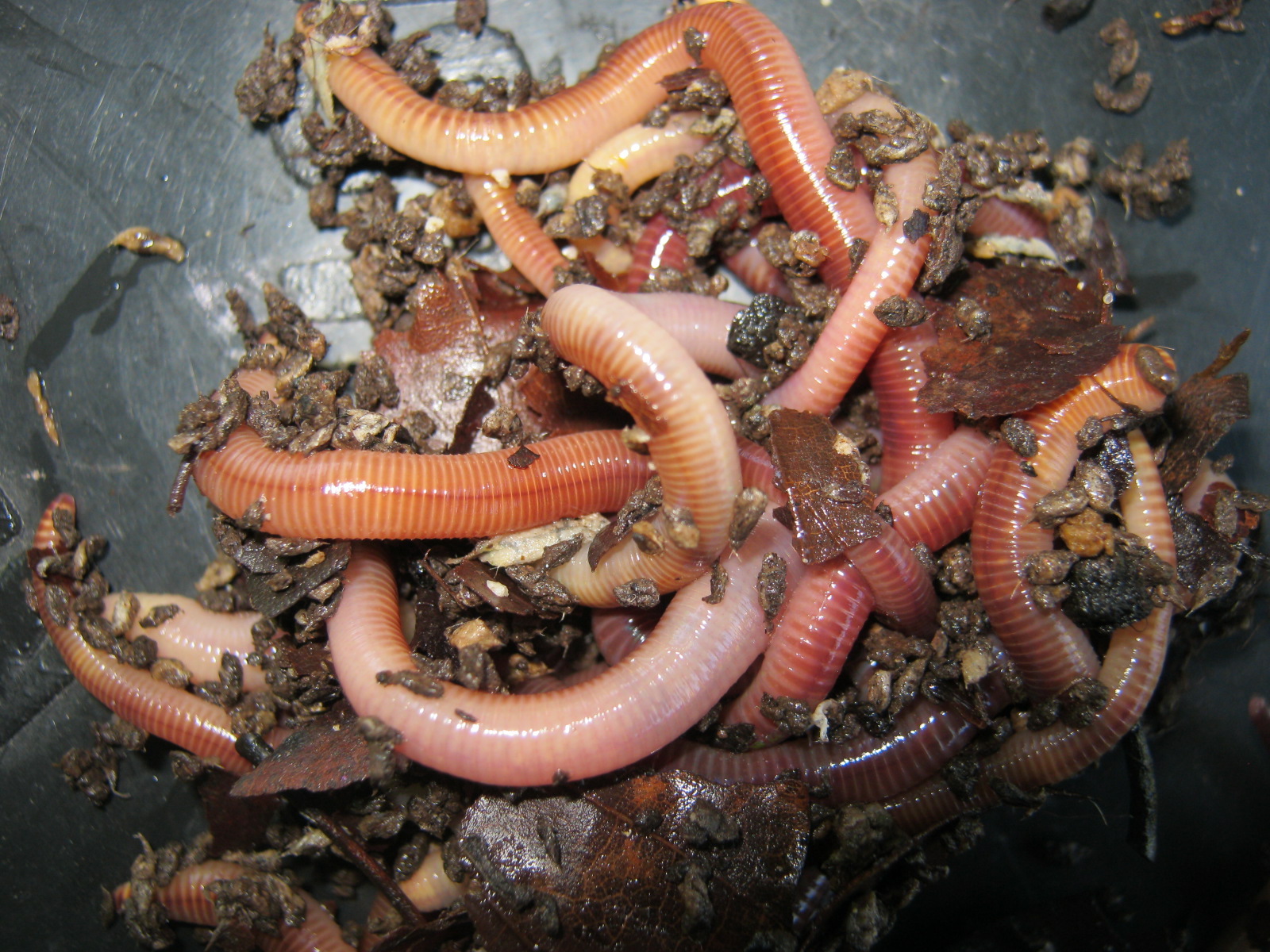Dear Reader, in this age of AI created content, please support with your goodwill someone who works harder to provide the human-made. Sign up at the top of the lefthand column or bottom of this page. You will receive my hand illustrated monthly newsletter RESTORE NATURE and access to the biodiversity garden design course as I write...and nothing else, I respect your time. I am also removing the advertizing as best I can as its become intrusive inappropriate and pays me nothing.
Natural garden design
designing your own eco friendly garden
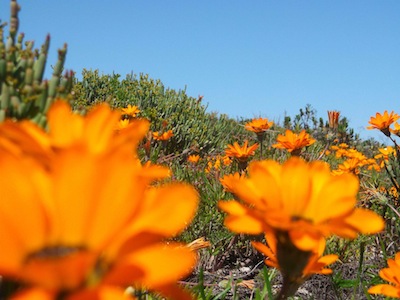 Nature, the model for natural garden design. A Cape sand dune with imitation worthy arrangement of succulents, bright flowers, and undulating land.
Nature, the model for natural garden design. A Cape sand dune with imitation worthy arrangement of succulents, bright flowers, and undulating land.How to design a natural garden
This section on natural garden design is to help people in urban spaces create a refuge for wild life and plant diversity while creating a beautiful wild looking garden.
What is the purpose of a natural garden ?
A 'natural' garden is just a word I'm using to describe a type of gardening. It uses nature as a model both in appearance and function, that is, it is brimming with 'nature' in terms of plants, insects, birds and small wild life, and it is close to nature in terms of attempting to protect species diversity in its methods. But its also follows the pattern of nature visually.
Learning about the ecological and functional relationships in the garden is ongoing, ever deepening, and one will cross many thresholds of understanding and make many mistakes, so fear must be fought. Insect and bird numbers and diversity are plummeting down worldwide. 70% of our food depends on insect pollination. Nature needs us now in this time of crisis, and that 'nature' includes human beings. We must bravely come to her aid and do whatever we can.
In the natural garden, the habitat created for wildlife and plant diversity is really the most important thing. Growing food and looking after human needs is integrated with the needs of garden wildlife rather than dominating, or even eliminating it. The waste streams coming from the human dwelling are recycled for the benefit of the garden and its denizens, from the soil microbes upward. But the human who creates the garden is not left outside the refuge. Humans and their needs are fulfilled in the garden, but integrated harmoniously with as much of the rest of creation as possible. Space to be nourished by, to study, contemplate and enjoy the garden is part of the ecosystem, just as it would be for a bird.
Appearance takes second place. The aim is to lessen the destructive human footprint and increase the creation of habitats, the support of all of nature and empowering it to thrive and do its own thing in the small refuge of the garden.
There are many movements around the world that are about rewilding gardens, from the creation of flowering meadows with prairie plants in North America, to the wildlife gardens of England and the Naturgarten of the German speaking world, and the creation of food forests in Malawi. These forms of gardening operate on new paradigms and with new techniques and there is so much to learn from them and to translate into the space you are in, wherever it is in the world.
I come for the Fynbos biome, one of the plant diversity hotspots of the world. Here there is an abundance of habitats and high geographic diversity in which there are different species and varieties found in very small areas, like one river valley, and these plants may not be found anywhere else. They call it a high rate of endemism.
But this very diversity adds another dimension to the creation of wild natural gardens at the Cape, and that is strictly finer grain, more local locality. It can be hard to get plants of the same variety as those which once grew on your land.
What is the natural garden style ?
Although the main function of a natural garden is its ability to support diversity and wildlife, and this has the highest priority, following the appearance of nature is also part of the type of gardening I describe here.
This separates it from natural gardening in the sense of 'organic’ gardening and ‘permaculture’ or 'French intensive' in which following nature is more about avoiding poisons and mineral fertilizers, and producing food in a natural way, and isn't overly concerned with aesthetics of design, sometimes calling it superficial. Native plants are not absolutely necessary in the planting schemes of these food growing movements. They certainly don't advocate attempting to imitate the appearance of nature, at the most its structure, as in the tiers of the forest in permaculture.
The appearance of wildness in the garden also goes against the grain of many other ideas about gardening that are common, in which control of nature is the aim. One of the most bizarre and entertaining versions of this has to be the caricature of nature found in grottos of old English romantic gardening. Natural gardening is also different to many other common gardening styles like like English country, French formal, Italian, Japanese, tropical and so on, in that it does not aim to show man's art or artifice openly and unambiguously with evidence of vegetation sculpting, or with exaggerated foliage contrasts or flower color schemes. It appears at first glance more like a piece of wilderness. Locality is also vital. It aims for the appearance of local wild vegetation rather than the evocation of exotic locations. Neither does it center around display and show stopping specimen plants or collector's items. The plants can be humble and common outside the garden context. Even native plant displays in botanical gardens often aim to show off feature plants rather than recreate wilderness in all its ecological profundity.
Being closest to the English wildlife garden or the German Naturgarten in spirit, this natural gardening is still unlike them as they may take any aesthetic form or style which can accommodate the wild plants, and looking wild is only an 'option'. I feel a real natural garden has to at least try for wildness. Emulating and learning from the functions and relationships in a piece of wild vegetation take up some if not most of the space in such a garden.
What is so important about 'looking wild' ? Isn't it a fancy or a romantic pretention like that of the Romantics ? I don't think so. This use of style has a deep purpose. It is in the attempt to emulate nature, and also to work with it and let it rule many of the gardening processes that we acquire deeper and deeper appreciation of how vast and complex the natural network of relationships is. Gardener artists who do this show their understanding and sensitivity to nature's rhythms and function in the way they explain what they do.
Putting native plants into a rather rigid carpet bedding arrangement is not going to teach as as much about how nature works as trying and failing to recreate a piece of Fynbos, prairie, meadow, or a spring woodland. We need to understand nature's workings on as many levels as possible now in this time of ecological crisis, and every gardener who strives in this direction evolves the understanding of nature for society at large. We cannot wait for science to discover ecological relationships and for that to filter down to us. At least that should not be our only means of enlightenment. It is dangerously slow moving. We need practical and personal experience of ecology. I know in my own life that observation has taught me things I couldn't quite explain that then shaped my practice. The science only followed decades later. I'm sure many gardeners have undergone a similar evolution. Nature needs all the help it can get and the most understanding possible, and the way to understanding is through more diverse and intense experience of nature.
What techniques are used in natural gardening ?
Like the Naturgarten, the prairie garden and the wildlife garden, this type of natural garden is different in the methods it uses to much gardening that has gone before, in terms of control. The most important technique is I guess, letting nature rule, letting be, not tidying up beyond the bare ecological necessity, like thinning invaders or removing diseased material.
Whereas conventional 'landscaping' is free to go for a natural wild 'look' while using poisons, natural garden design works up from the molecular level, planning in poison free modeling of nature into the garden's design.
Natural gardening, in the sense purveyed on this website, integrates the understanding of soils in regenerative agriculture where enrichment of the soil nutrients is one goal, and its seeming contradiction, the wildlife garden, in which often the goal is to provide nutrient poor soil so that the vigorous grasses are inhibited and wild flowers can thrive. The fact that these diverging soil regimes can be used in one system is proved by Markus Gastl's three zone system. The planning system here, on this website, is inspired by Markus Gastl, integrating his 3 zone garden with the outer world that contains the garden, and the inner worlds of the home contained by the garden, and the waste streams it produces turning them into resources. I have experience of growing food, making a food forest, composting humanure, vermiculture, soil building techniques, building earth ovens, fish ponds and grey water wetlands and I'll include links to these topics at the bottom of the page.
The understanding of gardening which requires a lot of color and flowers, the elimination of 'pests' and 'weeds' and a tidy appearance with a lawn and perhaps clipped hedges is turned on its head. In a nature garden the needs of the non human denizens are paramount and they require neglected corners and plenty of seed heads.
So such a garden would never be dominated by the stamp of man. You will not see artifice that forces the plants into unnatural relationships and requires high levels of inputs and control. Fuss and a lot of staging of great swathes of color and what they call 'wow' effect is not on the cards as the main agenda. You will not see the skills required for this artifice. Other skills will become strengthened.
However, natural gardens do impress. The insects love flowers, just like we humans do, and there are plenty of flowers in a wildlife garden. Makign a natural garden is also quite a bit of work. When laying out the garden, diverse habitats must be created. This may involve a lot of moving of materials and building. An understanding of succession and your local ecologies and seasonal changes must be acquired, so studying is required. Observation of natural companion plants in the local environment must be made. Authentically local seeds and plants which support wildlife must be sought, and this requires looking for sources of this plant material. After establishment, these gardeners still battle against unwanted invaders, seeking to create a balance, and thus support diversity. Last but not least, its not a garden that you design in detail, build in week and then just leave. Establishment needs to be followed up with responsive actions as things change, and a lifetime of watching over the natural processes like shade and invader encroachment, succession, soil and diversity change, and guiding them.
 The exquisite patterning in dune vegetation. You can bring these patterns from the wilderness around the city into small private spaces.
The exquisite patterning in dune vegetation. You can bring these patterns from the wilderness around the city into small private spaces.A natural garden, though man made, seeks to locate itself in general appearance with the local eco systems occurring naturally, planting swamp gardens in swamps and forest gardens in forests, and it prioritizes the use of native plants, to connect the garden with wider ecosystems on the level of insect and other dependencies on local flora.
However, in the interest of diversity, small habitats may be created which were not there before and are 'artificial'. This applies especially to endangered habitats like wetlands. One can grow many wetland species in a really tiny man-made wetland and give the dependent wetland creatures a refuge as they move around the urban landscape.
Unlike a piece of a man-made 'nature reserve' or restoration of the natural vegetation, natural gardening does not ban use of all exotics. If exotic plants support wildlife, the indigenous support having been lost, or if the exotics are necessary to feed humans, or if they are not invasive or do not present a danger to the local genetic pool, then they may be incorporated in the garden.
Because even the smallest planting can provide a refuge to insects, and a micro habitat, planting in pots and containers, cracks in the road and along canals are all part of the urban project. Even topiary can be insect friendly if you prune at the right time when wildlife sheltering in the hedge will not be harmed. Boundaries can be made more wildlife friendly, depending on how you build garden fences and walls and plant hedges to include shelter and food for small animals.
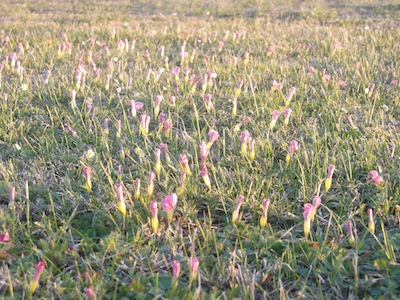 A field of indigenous pink Oxalis in a park in Cape Town overlaps public space management with natural garden design.
A field of indigenous pink Oxalis in a park in Cape Town overlaps public space management with natural garden design.What skills do we need to design a natural garden ?
Nature is not some man made artifice. It is infinitely larger than us, and we do not see any more than a tiny crack in its edifice. We can only design according to nature, in as far as information is available to us, so learning is important. We can only follow a model we know, so the more we learn, the better the imitation should be.
This learning is not only from books (or google), but the intimate continually evolving working relationship a gardener has with the things they grow and the environment of the garden. It also requires the observational skill of an artist, to recognize visual patterns, which skill develops the more one observes. It is like a muscle.
But certain things can only be discovered by reading, such as the science of the soil microbiome, the role of root exudates in soil regeneration, and the methodology for building a forest discovered by Akira Miyawaki and Shubhendu Sharma for building small forests in just ten years.
So after this brief outline of natural gardening, we need to explore the elements which make it what it is. These are things like wildlife, diverse native plants, nature friendly food plants, shaping the land, building materials, different types of mini habitats, managing the soil, and so on. Where I have personal experience I will certainly speak about that.
For ease of use I'll compile a list of these topics below.
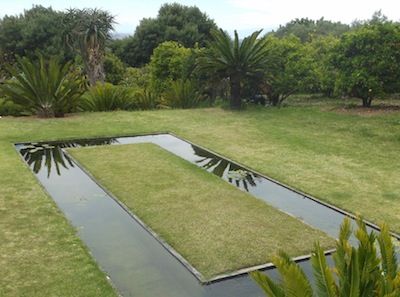 A lovely calming example of what 'landscape gardening' can be. It balances the inner ecosystem of the garden user.
A lovely calming example of what 'landscape gardening' can be. It balances the inner ecosystem of the garden user.------
home page for overview of the links to gardening information and methods
------
------
understanding beautiful drought tolerant plants
------
water-wise gardening practice, introduction
------
planning your planting in a Mediterranean garden
------
start your own pocket forest ecosystem project
------
natural random spacing in herb garden design
------
albums of wild flower photographs for visual inspiration
------
collections of garden design and flower images
You’re a home gardener ! Share your experiences and questions !
We all know about home gardening. Tell us about your successes, challenges and ask about issues that bother you. You may have the luxury of a back garden, but there are other ways we learn. Few people age without growing something or buying vegetables during their lives ! It is absolutely guaranteed that you have learned things which can help others on their gardening journey.
We invite you to share your stories, ask questions, because if a thing has bothered you it will bother others too. Someone may have a solution ! No question is too small. There is learning for everyone involved, for you, for me (yes, I learn from every question), for us all. Exciting stuff !
We are starting on a new journey. Every week we will profile your letters ! The best stories and questions we receive.
What Other Visitors Have Said
Click below to see contributions from other visitors to this page...
This is the catch pool for my favourite drinking fountain at Kirstenbosch 




I love this tiny rock pool under the drinking fountain.
Restore Nature Newsletter
I've been writing for four years now and I would love to hear from you
Please let me know if you have any questions, comments or stories to share on gardening, permaculture, regenerative agriculture, food forests, natural gardening, do nothing gardening, observations about pests and diseases, foraging, dealing with and using weeds constructively, composting and going offgrid.
SEARCH
Order the Kindle E-book for the SPECIAL PRICE of only
Prices valid till 30.09.2023
Recent Articles
-
garden for life is a blog about saving the earth one garden at a time
Apr 18, 25 01:18 PM
The garden for life blog has short articles on gardening for biodiversity with native plants and regenerating soil for climate amelioration and nutritious food -
Cape Flats Sand Fynbos, Cape Town's most endangered native vegetation!
Apr 18, 25 10:36 AM
Cape Flats Sand Fynbos, a vegetation type found in the super diverse Cape Fynbos region is threatened by Cape Town's urban development and invasive alien plants -
Geography Research Task
Jan 31, 25 11:37 PM
To whom it may concern My name is Tanyaradzwa Madziwa and I am a matric student at Springfield Convent School. As part of our geography syllabus for this
"How to start a profitable worm business on a shoestring budget
Order a printed copy from "Amazon" at the SPECIAL PRICE of only
or a digital version from the "Kindle" store at the SPECIAL PRICE of only
Prices valid till 30.09.2023

